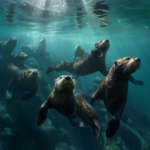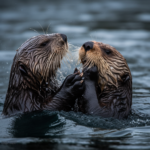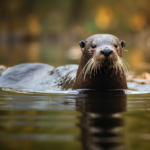Sea otters, also known as marine otters, are fascinating creatures that inhabit coastal waters of the northern and eastern Pacific Ocean. These adorable marine mammals have captured the hearts of many with their playful behavior and endearing appearance. But have you ever wondered what sea otters eat to sustain their energetic lifestyle? In this article, we will delve into the dietary habits of sea otters, exploring the wide variety of foods they consume to meet their nutritional needs. From shellfish to sea urchins, sea otters have a diverse diet that plays a crucial role in maintaining the delicate balance of their marine ecosystems. So, let’s dive in and discover the fascinating world of sea otter cuisine!
Key Takeaways
- Sea otters primarily eat marine invertebrates such as sea urchins, crabs, clams, and snails.
- They have a high metabolic rate and need to consume a large amount of food daily to maintain their body temperature.
- Sea otters use tools, such as rocks, to crack open hard-shelled prey.
- Their diet plays a crucial role in maintaining the health of kelp forests by controlling the population of sea urchins.
- Conservation efforts are important to protect sea otters and ensure their food sources are abundant.
The Diet of Sea Otters: An Overview
Sea otters are fascinating aquatic mammals known for their playful behavior and charming appearance. But have you ever wondered what these adorable creatures eat? In this section, we will explore the diet of sea otters, both in the wild and in captivity, and discuss the most common foods that make up their diet.
A. What Sea Otters Eat in the Wild
Sea otters are skilled hunters and have a diverse diet that primarily consists of marine invertebrates. They play a crucial role in maintaining the balance of the kelp forest ecosystem by controlling the populations of certain prey species. Let’s take a closer look at some of the key food sources for sea otters in the wild:
-
Sea Urchins: Sea otters have a particular fondness for sea urchins. These spiky creatures feed on kelp, and when their populations grow unchecked, they can devastate entire kelp forests. Sea otters help keep the sea urchin population in check by preying on them.
-
Crabs: Crabs are another important part of a sea otter‘s diet. Sea otters use their dexterous paws to capture crabs hiding among the rocks and kelp. They have been observed using rocks as tools to crack open the shells of crabs and other hard-shelled prey.
-
Clams: Sea otters are skilled divers and can hold their breath for several minutes. They use this ability to their advantage when hunting for clams. Sea otters dive to the ocean floor, locate clams buried in the sand, and use their strong teeth to pry them open.
-
Abalone: Abalone, a type of marine snail, is a delicacy for sea otters. These mollusks have a tough shell, but sea otters are adept at breaking them open using rocks or other hard objects.
-
Mussels: Mussels are another common food source for sea otters. These bivalve mollusks are found in abundance along rocky coastlines, making them easily accessible for otters.
B. What Sea Otters Consume in Captivity
In captivity, sea otters are provided with a carefully curated diet that aims to replicate their natural feeding habits as closely as possible. The diet of captive sea otters typically includes a variety of seafood, such as fish, squid, and shellfish. This ensures that they receive the necessary nutrients for their overall health and well-being.
Captive sea otters are often fed a mixture of whole prey items and commercially prepared diets. The goal is to provide a balanced diet that meets their nutritional requirements while also stimulating their natural foraging instincts. This helps keep the otters mentally and physically active, mimicking their natural hunting behaviors.
C. The Most Common Foods in a Sea Otter’s Diet
Sea otters have a diverse diet, but some foods are more commonly consumed than others. Here are some of the most common foods that make up a sea otter‘s diet:
- Sea urchins
- Crabs
- Clams
- Abalone
- Mussels
- Fish
- Squid
- Shrimp
- Crustaceans
These food sources provide sea otters with the necessary nutrients, such as protein, fats, and minerals, to support their energy needs and overall health.
In conclusion, sea otters are opportunistic feeders that rely on a variety of marine invertebrates for their survival. Whether in the wild or in captivity, their diet consists of a range of shellfish, crustaceans, and other prey species. By understanding their feeding habits and dietary needs, we can better appreciate the important role sea otters play in maintaining the delicate balance of the oceanic food web.
The Significance of Invertebrates in a Sea Otter’s Diet
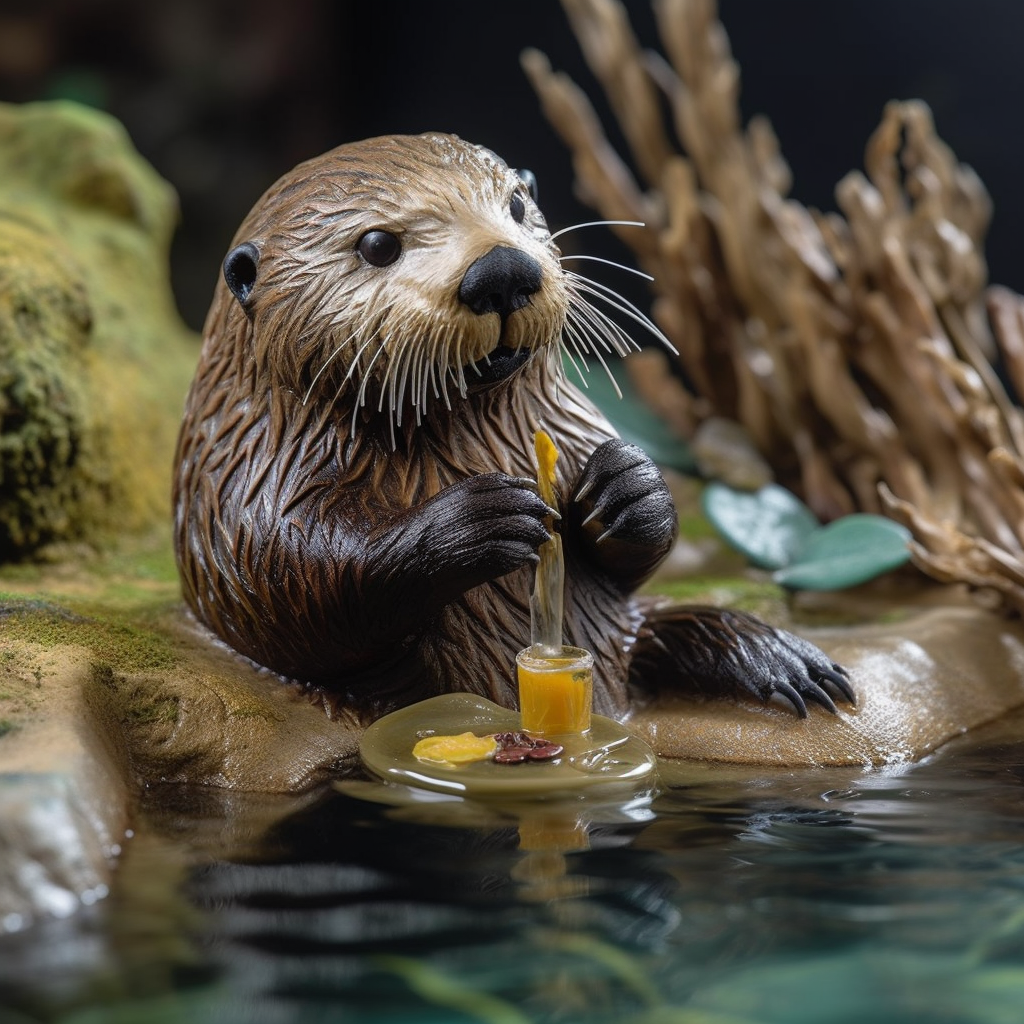
Sea otters are known for their voracious appetite and diverse diet. They play a crucial role in maintaining the balance of the kelp forest ecosystem by consuming a variety of invertebrates. Let’s explore why sea otters primarily eat invertebrates and the specific role that crabs, urchins, octopus, and abalone play in their diet.
A. Why Sea Otters Eat Invertebrates
Sea otters are aquatic mammals that rely on the ocean for their survival. Their feeding habits are adapted to their marine environment, where they have access to a wide range of food sources. Invertebrates, which are animals without a backbone, form a significant part of a sea otter‘s diet.
One reason sea otters consume invertebrates is their abundance in coastal ecosystems. Invertebrates such as crabs, clams, mussels, and sea urchins are plentiful in the ocean, making them easily accessible prey for sea otters. These creatures provide a rich source of nutrition, allowing sea otters to meet their dietary needs.
Another reason sea otters primarily eat invertebrates is their hunting techniques. Sea otters are skilled hunters, using their dexterous paws and sharp teeth to capture and consume their prey. Invertebrates, with their soft bodies and shells, are easier for sea otters to catch and consume compared to larger, more elusive prey.
B. The Role of Crabs and Urchins in Their Diet
Crabs and sea urchins are two key invertebrates that play a vital role in a sea otter‘s diet. Sea otters have a particular fondness for crabs, which are often found in rocky coastal areas. Crabs provide a good source of protein and are rich in nutrients, making them an essential part of a sea otter‘s diet.
Sea urchins, on the other hand, are known for their destructive feeding habits on kelp forests. When sea otters consume sea urchins, they help control their population and prevent overgrazing of kelp. This, in turn, allows the kelp forest ecosystem to thrive, benefiting a wide range of marine species.
C. How Sea Otters Eat Octopus and Abalone
While crabs and sea urchins form a significant portion of a sea otter‘s diet, they also consume other invertebrates such as octopus and abalone. Octopus are highly intelligent creatures that can be challenging to catch. However, sea otters have developed clever hunting techniques to capture and consume octopus, including using rocks to break open their hiding places.
Abalone, a type of marine snail, is another delicacy for sea otters. These mollusks are found in rocky coastal areas and provide a valuable source of nutrients. Sea otters use their strong teeth to pry abalone from rocks and consume them.
In conclusion, invertebrates play a crucial role in a sea otter‘s diet. Sea otters rely on the abundance of invertebrates in the ocean to meet their nutritional needs. Crabs and sea urchins help maintain the balance of the kelp forest ecosystem, while octopus and abalone provide a diverse and nutritious food source. By consuming these invertebrates, sea otters contribute to the health and stability of the marine food chain.
The Peculiar Eating Habits of Sea Otters
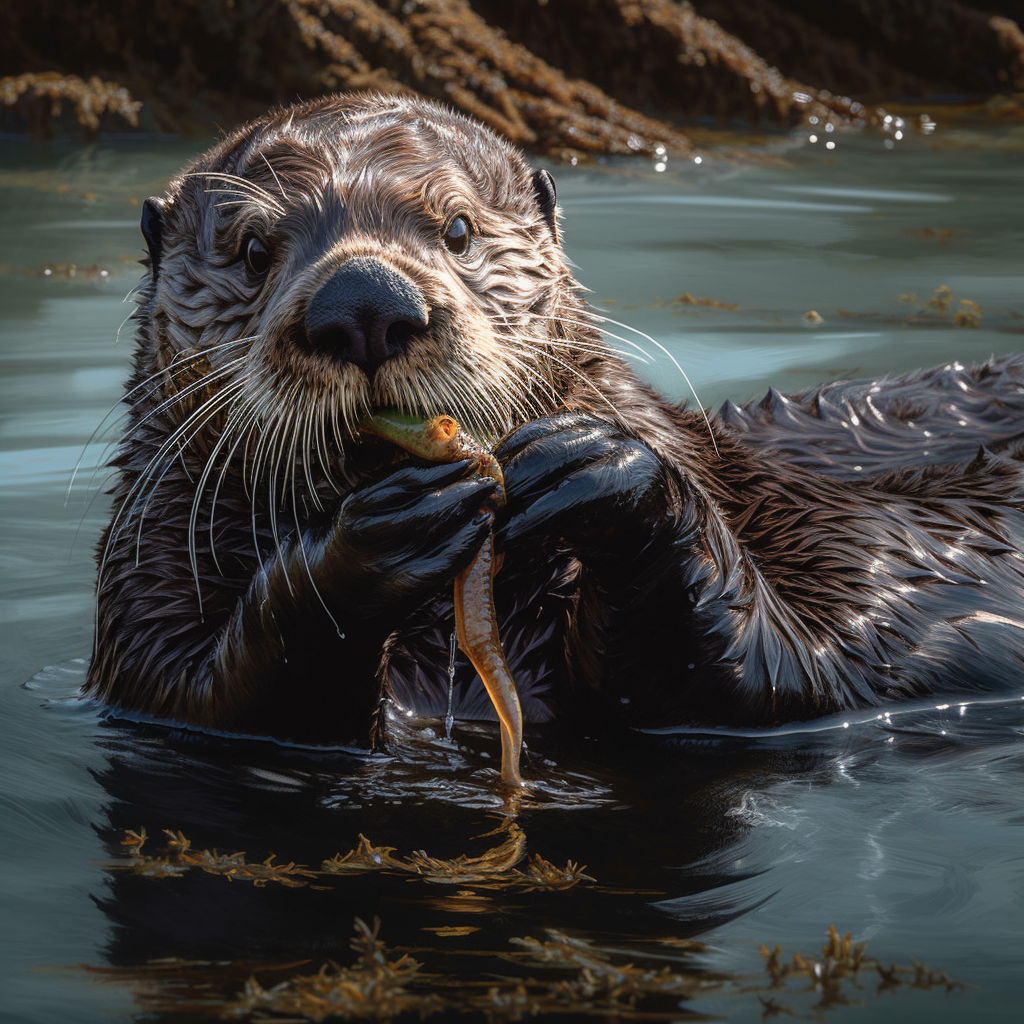
Sea otters are fascinating creatures known for their unique eating habits. In this section, we will explore how sea otters eat, why they eat on their backs, and where they find their feeding grounds.
A. How Sea Otters Eat: A Unique Approach
Sea otters have a distinct way of feeding that sets them apart from other marine mammals. They are well-adapted to their aquatic lifestyle and have developed specialized techniques for obtaining their food.
When it comes to hunting, sea otters primarily rely on their dexterous front paws, which are equipped with sharp claws. These nimble paws allow them to grasp and manipulate their prey with ease. Sea otters are opportunistic feeders, meaning they will consume a wide variety of prey depending on what is available in their habitat.
One of the sea otter’s favorite food sources is shellfish, such as sea urchins, crabs, clams, abalone, and mussels. To access the meat inside these hard-shelled creatures, sea otters use rocks as tools. They will often dive to the ocean floor, select a suitable rock, and bring it back to the surface. Using this rock as an anvil, they repeatedly strike the shellfish against it until it cracks open, revealing the tasty meal inside.
Sea otters are also known to feed on other marine invertebrates, small fish, and even occasionally on birds. They are skilled divers and can hold their breath for several minutes while searching for food underwater. Their streamlined bodies and webbed feet enable them to swim swiftly and maneuver effortlessly through the water.
B. Why Sea Otters Eat on Their Backs
One of the most peculiar aspects of sea otter feeding behavior is their habit of eating on their backs. This behavior serves a practical purpose and allows them to consume their food more efficiently.
When sea otters capture their prey, they bring it to the surface and place it on their chest. They then float on their backs, using their stomachs as a table. This unique posture allows them to have better control over their food and provides them with a stable platform for eating.
By eating on their backs, sea otters can use their front paws to hold their food securely while using their teeth to tear it apart. This method also enables them to keep an eye out for potential threats while enjoying their meal. It’s an ingenious adaptation that showcases the resourcefulness of these remarkable creatures.
C. Where Sea Otters Eat: Feeding Grounds Explored
Sea otters can be found in a variety of habitats, including coastal areas, estuaries, and kelp forests. These habitats provide an abundant food supply for sea otters, making them ideal feeding grounds.
Kelp forests, in particular, are crucial for the survival of sea otters. These underwater ecosystems are home to a diverse range of marine life, including the sea otter’s preferred prey. Sea otters play a vital role in maintaining the balance of the kelp forest ecosystem by controlling the population of sea urchins, which feed on kelp.
Sea otters are known for their foraging skills and can cover large areas in search of food. They are highly mobile and will travel long distances to find suitable feeding grounds. Their ability to adapt to different environments and exploit available food sources contributes to their survival in the ever-changing marine food chain.
In conclusion, sea otters have peculiar eating habits that are perfectly suited to their aquatic lifestyle. Their unique approach to feeding, including the use of tools and eating on their backs, showcases their adaptability and resourcefulness. By understanding how sea otters eat, we can gain a deeper appreciation for these fascinating creatures and the important role they play in the oceanic food web.
The Frequency and Quantity of Sea Otters’ Food Intake
Sea otters are fascinating creatures that inhabit coastal waters, where they play a vital role in maintaining the balance of the marine ecosystem. These adorable aquatic mammals have unique feeding habits that are essential for their survival. In this section, we will explore how often sea otters eat, how much they consume every day, and why they eat so much.
A. How Often Do Sea Otters Eat
Sea otters are known to be voracious eaters, and they typically feed multiple times throughout the day. On average, they spend about four to five hours each day foraging for food. This means that they dedicate a significant portion of their time to finding and consuming their preferred prey.
B. How Much Do Sea Otters Eat Every Day
Sea otters have high metabolic rates, which require them to consume a substantial amount of food to meet their energy needs. On average, an adult sea otter can consume up to 25% to 30% of its body weight in food each day. This means that a 50-pound sea otter may eat around 12 to 15 pounds of food daily!
C. Why Sea Otters Eat So Much: An Insight into Their Metabolism
The reason sea otters eat such large quantities of food is closely tied to their metabolism. Unlike other marine mammals, sea otters lack a layer of blubber to keep them warm in the cold ocean waters. Instead, they rely on their dense fur and a high metabolic rate to generate heat and maintain their body temperature.
To sustain this high metabolic rate, sea otters need to consume a diet rich in calories. Their preferred food sources, such as shellfish and other marine invertebrates, provide them with the necessary energy to fuel their active lifestyle. By consuming a large quantity of food, sea otters can meet their energy requirements and stay warm in their chilly ocean habitat.
Sea otters are skilled hunters and employ various techniques to capture their prey. They are known to use rocks as tools to crack open the shells of their favorite food items, such as sea urchins, crabs, clams, abalone, and mussels. This adaptation allows them to access the nutrient-rich flesh inside the hard shells.
In addition to their impressive hunting skills, sea otters also play a crucial role in maintaining the health of kelp forest ecosystems. By feeding on sea urchins, which are natural predators of kelp, sea otters help control their population and prevent overgrazing of kelp forests. This, in turn, promotes the growth and diversity of other marine life within the ecosystem.
In conclusion, sea otters have a high food intake frequency and consume a significant amount of food every day. Their metabolism and lack of blubber necessitate this large food consumption to meet their energy needs and maintain their body temperature. By understanding the feeding habits of sea otters, we can appreciate their vital role in the marine food chain and the delicate balance of the oceanic ecosystem.
The Role of Plants and Kelp in a Sea Otter’s Diet
Sea otters are fascinating creatures that inhabit coastal waters, where they play a vital role in maintaining the health of marine ecosystems. One of the key aspects of their lifestyle is their diet, which primarily consists of a variety of marine plants and animals. In this section, we will explore the role of plants and kelp in a sea otter‘s diet, the specific plants they consume, and the importance of kelp forests for their survival.
A. What Role Does Kelp Play in Their Diet?
Kelp, a type of large brown seaweed, is a crucial component of a sea otter‘s diet. These marine mammals are known to be highly dependent on kelp forests for their survival. Kelp provides sea otters with both food and shelter, making it an essential resource for their well-being.
Sea otters are skilled divers and foragers, and they actively search for kelp beds to find their preferred prey. Kelp acts as a natural anchor, creating a stable environment where sea otters can hunt and feed. The dense canopy of kelp fronds also provides protection from predators and rough ocean currents, allowing sea otters to rest and groom themselves in relative safety.
B. What Plants Do Sea Otters Eat?
In addition to kelp, sea otters consume a variety of other marine plants. They have a diverse palate and are known to feed on different types of algae, seagrasses, and even terrestrial plants found near the coast.
Sea otters are particularly fond of sea urchins, which are spiky creatures that feed on kelp. When sea urchin populations become too abundant, they can overgraze kelp forests, leading to the destruction of this vital habitat. Sea otters play a crucial role in maintaining a balance by preying on sea urchins, thus preventing the overconsumption of kelp.
Apart from sea urchins, sea otters also feed on a variety of shellfish, including crabs, clams, abalone, and mussels. They use their dexterous paws to search for and capture these prey items, often cracking open shells with rocks or other hard objects. This ability to exploit a wide range of food sources makes sea otters adaptable and resilient in their foraging habits.
C. The Importance of Kelp Forests for Sea Otters
Kelp forests are not only crucial for sea otters’ diet but also for their overall well-being. These underwater ecosystems provide a rich and diverse habitat for a multitude of marine species. The dense kelp canopy offers protection and shelter for various organisms, including fish, invertebrates, and other marine mammals.
Furthermore, kelp forests help regulate the health of coastal ecosystems by acting as carbon sinks, absorbing carbon dioxide from the atmosphere and reducing the impacts of climate change. They also provide nursery grounds for many commercially important fish species, contributing to the sustainability of fisheries.
In conclusion, plants and kelp play a vital role in a sea otter‘s diet. Kelp provides sea otters with food and shelter, while other marine plants and shellfish diversify their diet. The dependence of sea otters on kelp forests highlights the importance of preserving these unique ecosystems for the survival of not only sea otters but also the entire marine food chain.
Sea Otters’ Diet Across Different Regions
Sea otters are fascinating creatures that inhabit various coastal regions, including Oregon and Alaska. These marine mammals have distinct food preferences depending on their environment. Let’s explore what sea otters eat in these regions and how their food choices are influenced by their surroundings.
A. What Do Sea Otters Eat in Oregon and Alaska
In both Oregon and Alaska, sea otters primarily feed on a variety of marine organisms found in their habitats. These otters are known for their remarkable hunting skills and diverse diet. Here are some of the main food sources for sea otters in these regions:
-
Shellfish: Sea otters have a particular affinity for shellfish, which make up a significant portion of their diet. They have a knack for cracking open shells using rocks or other hard objects. Sea otters consume a wide range of shellfish, including sea urchins, crabs, clams, abalone, and mussels. These creatures provide essential nutrients and energy for the otters‘ survival.
-
Fish: While shellfish dominate their diet, sea otters also consume fish when available. They are skilled hunters and can catch fish using their agile swimming abilities. Common fish species consumed by sea otters include salmon, herring, and rockfish. Fish provide an additional source of protein and nutrients for these marine mammals.
-
Invertebrates: Sea otters have a diverse palate and feed on various invertebrates. They often target sea stars, sea cucumbers, and squid, among other invertebrate species. These organisms contribute to the otters‘ nutritional needs and add variety to their diet.
B. The Impact of Environment on Sea Otters’ Food Choices
The availability of food sources greatly influences the diet of sea otters. The unique ecosystems in Oregon and Alaska play a crucial role in shaping the otters‘ food choices. Here are some factors that impact their diet:
-
Kelp Forest Ecosystem: Sea otters in both Oregon and Alaska inhabit kelp forest ecosystems. These underwater forests provide a rich and diverse habitat for a wide range of marine organisms. Sea otters rely on the kelp forest ecosystem for their food sources, as it supports abundant populations of shellfish and other prey species.
-
Otter Hunting Techniques: Sea otters employ various hunting techniques to capture their prey. They use their dexterous paws and sharp teeth to extract shellfish from rocks or pry open shells. Their hunting skills have evolved to suit the specific food sources available in their environment.
-
Sea Otter Population Density: The density of sea otter populations in a particular region can affect their food choices. In areas with higher otter populations, competition for food resources may be more intense, leading to a greater reliance on specific prey species.
Understanding the diet of sea otters across different regions is essential for studying their behavior, habitat requirements, and overall conservation. By examining the food sources available to sea otters in Oregon and Alaska, researchers can gain insights into the intricate relationships within the marine food chain and ensure the preservation of these remarkable creatures.
| Food Sources | Oregon | Alaska | |————–|——–|——–| | Shellfish | ✔️ | ✔️ | | Fish | ✔️ | ✔️ | | Invertebrates| ✔️ | ✔️ |
In conclusion, sea otters in Oregon and Alaska have a diverse diet that includes shellfish, fish, and various invertebrates. Their food choices are influenced by the unique ecosystems they inhabit, such as the kelp forest environment. By studying their diet and the factors that shape it, we can better understand the nutritional needs and conservation requirements of these remarkable marine mammals.
The Feeding Behaviors of Sea Otters

Sea otters are fascinating creatures known for their playful nature and their unique feeding habits. In this section, we will explore two aspects of sea otter feeding behaviors: how they feed their young and how they consume clams and other hard-shelled creatures.
A. How Sea Otters Feed Their Young
Sea otters are excellent parents and take great care of their offspring. When it comes to feeding their young, sea otter mothers play a crucial role. They nurse their pups for the first few months of their lives, providing them with the necessary nutrients for growth and development.
Sea otter milk is rich in fat and protein, which helps the pups gain weight quickly. The mother‘s milk is so nutritious that the pups can double their weight in just a few weeks. As the pups grow older, they start to eat solid food, gradually transitioning from milk to a more varied diet.
The mother sea otter teaches her pups how to forage for food. She brings them to areas abundant in prey, such as kelp forests or rocky shores, and shows them how to hunt and catch their own food. This process of learning from their mother is essential for the survival and independence of the young sea otters.
B. How Sea Otters Eat Clams and Other Hard-Shelled Creatures
Sea otters are well-known for their ability to crack open hard-shelled prey, such as clams, abalone, and mussels. They have specialized adaptations that allow them to access these food sources.
When hunting for clams or other shellfish, sea otters dive underwater and use their sensitive paws to search for their prey. Once they locate a clam or mussel, they bring it to the surface and place it on their chest. Using a rock or another hard object, they repeatedly strike the shell until it cracks open, revealing the tasty meal inside.
Sea otters have loose folds of skin under their forelimbs, which they use as pockets to store their food while they continue hunting. This behavior allows them to gather multiple prey items before returning to the surface to eat. It’s not uncommon to see a sea otter floating on its back, using its chest as a table to enjoy its meal.
In addition to clams, sea otters also consume other hard-shelled creatures like crabs and sea urchins. They employ similar techniques to crack open these prey items, using rocks or other tools to break through the tough exteriors.
Sea otters play a vital role in the kelp forest ecosystem by controlling the populations of sea urchins. These spiky creatures feed on kelp, and if left unchecked, they can decimate entire kelp forests. By preying on sea urchins, sea otters help maintain the balance of the ecosystem and ensure the survival of other species that rely on kelp for shelter and food.
In conclusion, sea otters have fascinating feeding behaviors. They not only provide nourishment to their young through nursing but also teach them how to forage for food. Their ability to crack open hard-shelled prey showcases their resourcefulness and adaptability. By understanding the feeding habits of sea otters, we can appreciate their important role in maintaining the health of marine ecosystems. Conclusion
In conclusion, sea otters have a diverse diet that consists mainly of marine invertebrates such as clams, crabs, sea urchins, and abalone. They are skilled hunters and use their dexterous paws to forage for food in the ocean. Sea otters also have a unique feeding behavior where they often float on their backs and use rocks as tools to crack open shells. This allows them to access the nutritious meat inside. Additionally, sea otters consume a variety of other prey including fish, squid, and octopus. Their diet is crucial to their survival and plays a vital role in maintaining the health of coastal ecosystems. By controlling the populations of certain prey species, sea otters help maintain the balance of marine ecosystems. Overall, sea otters are fascinating creatures with a specialized diet that showcases their adaptability and importance in the marine environment.
Frequently Asked Questions
Q1: Why do sea otters eat invertebrates?
Sea otters eat invertebrates because they are a rich source of protein and nutrients. Invertebrates like sea urchins, crabs, clams, and mussels are a significant part of the sea otter diet, providing the necessary energy for their high metabolic needs.
Q2: What do sea otters eat in the wild?
In the wild, sea otters consume a variety of marine life, primarily invertebrates. This includes sea urchins, crabs, clams, abalone, and mussels. They also eat some species of fish and occasionally small aquatic mammals.
Q3: How do sea otters eat urchins?
Sea otters use their strong teeth and jaws to crack open the hard shells of sea urchins. They also use rocks as tools, smashing the urchin against them to break them open.
Q4: Why do sea otters eat so much?
Sea otters have a high metabolic rate, which requires a substantial amount of food for energy. They consume approximately 25% of their body weight in food each day to maintain their body temperature in the cold oceanic environment.
Q5: What do sea otters eat in captivity?
In captivity, sea otters are typically fed a diet that mimics their natural food sources. This includes a variety of shellfish like clams, mussels, and crabs, as well as fish and sometimes squid.
Q6: How often do sea otters eat?
Sea otters eat frequently throughout the day, typically every few hours. This is due to their high metabolic rate and the need to maintain their body temperature.
Q7: How do sea otters feed their young?
Sea otter mothers feed their young by catching food and bringing it back to them. The mother will often chew the food and then feed it to the pup until it learns to hunt and eat on its own.
Q8: What fish do sea otters eat?
While their diet primarily consists of invertebrates, sea otters do eat some species of fish. The types of fish they eat can vary depending on their geographic location and availability of prey.
Q9: Why do sea otters eat on their backs?
Sea otters eat on their backs as a way to use their chest as a table. They often float on their backs while eating, holding their food with their front paws and using rocks to crack open hard-shelled prey.
Q10: What do sea otters eat in kelp forests?
In kelp forests, sea otters eat a variety of invertebrates that inhabit this ecosystem. This includes sea urchins, crabs, abalone, and various shellfish. By controlling sea urchin populations, otters play a crucial role in maintaining the health of kelp forests.

